
The Castle of Mey is located in Caithness, on the north coast of Scotland, about 6 miles (10 km) west of John o' Groats. In fine weather there are views from the castle north to the Orkney Islands.

Thurso is a town and former burgh on the north coast of the Highland council area of Scotland. Situated in the historical County of Caithness, it is the northernmost town on the island of Great Britain. From a latitudinal standpoint, Thurso is located further north than the southernmost point of Norway and in addition lies more than 500 miles (800 km) north of London.

Archibald Henry Macdonald Sinclair, 1st Viscount Thurso,, known as Sir Archibald Sinclair between 1912 and 1952, and often as Archie Sinclair, was a Scottish politician and leader of the Liberal Party.

Caithness is a historic county, registration county and lieutenancy area of Scotland.

Viscount Thurso, of Ulbster in the County of Caithness, is a title in the Peerage of the United Kingdom. It was created on 11 June 1952 for the Scottish Liberal politician and former Secretary of State for Air, Sir Archibald Sinclair, 4th Baronet. His son, the second Viscount, served as Lord Lieutenant of Caithness from 1973 to 1995.

Helmsdale is a village on the east coast of Sutherland, in the Highland council area of Scotland. The modern village was planned in 1814 to resettle communities that had been removed from the surrounding straths as part of the Highland Clearances.
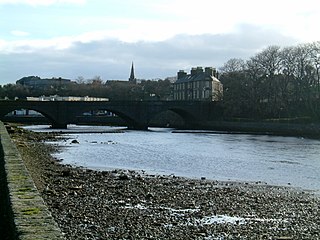
Wick is a town and royal burgh in Caithness, in the far north of Scotland. The town straddles the River Wick and extends along both sides of Wick Bay. "Wick Locality" had a population of 6,954 at the time of the 2011 census, a decrease of 3.8% from 2001.

Clan Sinclair is a Highland Scottish clan which holds the lands of Caithness, the Orkney Islands, and the Lothians. The chiefs of the clan were the Barons of Roslin and later the Earls of Orkney and Earls of Caithness.
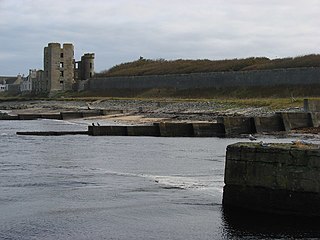
Thurso East is a coastline section of the Atlantic 0.5 miles (0.80 km) east of Thurso, Caithness, northern Scotland. It is situated at the mouth of the River Thurso, overlooked by the remains of Thurso Castle. The reef is made of layers of Caithness flagstone. It is Scotland's prime surfing venue on the north coast.

Braal Castle is located by the River Thurso north of the village of Halkirk, in Caithness, northern Scotland. The ruined castle, which dates back to the mid-14th century, was originally known as the Castle of Brathwell.

Roslin Castle is a partially ruined castle near the village of Roslin in Midlothian, Scotland. It is located around 9 mi (14 km) south of Edinburgh, on the north bank of the North Esk, only a few hundred metres from the famous Rosslyn Chapel.

The Battle of Alltan-Beath, also known as the Battle of Ailtan-Beath, was a Scottish clan battle said to have taken place in 1542 in the village of Knockarthur, in Sutherland, in the Scottish Highlands. It was fought between men of the Clan Mackay and men of the Clan Sutherland whose chiefs were the Gordon, Earls of Sutherland.

Keiss Castle is a partially ruined castle in Scotland, which stands on sheer cliffs overlooking Sinclair's Bay less than one mile north of Keiss village centre, Caithness, Highland, Scotland. It is protected as a scheduled monument. The old castle was replaced by Keiss House around 1755.
James Sinclair, 12th Earl of Caithness (1766–1823) was a Scottish noble, Earl of Caithness and chief of the Clan Sinclair, a Highland Scottish clan.
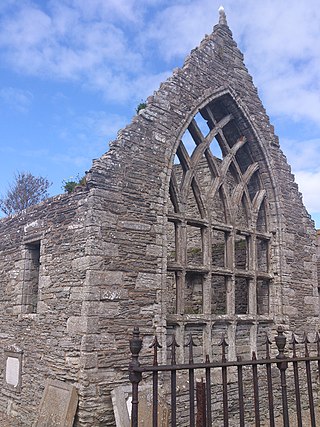
Auld St Peter's Kirk is a ruined parish church on Wilson Lane, in Thurso, Caithness, Scotland. Dedicated to Saint Peter, it dates to at least 1125, and at one time was the principal church for the county, administered by the Bishops of Caithness. It became a scheduled monument in 1929 and from 1975 until 2016 it was also a Category A listed building.
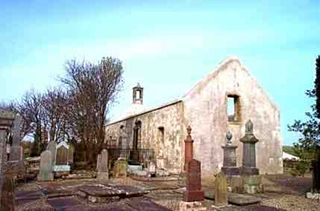
Halkirk Auld Kirk is a former parish church in Halkirk, Caithness, Scotland. Built in 1753, it stopped being used in 1934 and is now a ruin. Halkirk parish was formed at the time of the Reformation by the union of the Halkirk and Skinnet districts. The "Halkirk Village Old Parish Church And Burial Ground" is a category B listed building.
Dounreay Castle is a ruined 16th-century L-plan castle, about 8 miles (13 km) west of Thurso, Highland, Scotland, within the grounds of Dounreay Nuclear Power Development Establishment. It is also known as Dounreay House. The castle and its associated structures are a Scheduled Ancient Monument.
John Sinclair, Master of Caithness was a Scottish nobleman.
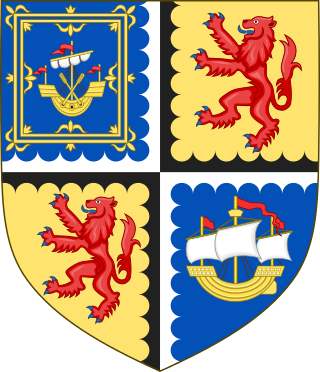
George Sinclair was a Scottish nobleman, 6th Earl of Caithness, and chief of the Clan Sinclair, a Scottish clan of the Scottish Highlands.

George Sinclair, previously of Keiss, died 1698, was a Scottish nobleman, 7th Earl of Caithness and chief of the Clan Sinclair, a Scottish clan of the Scottish Highlands.


















